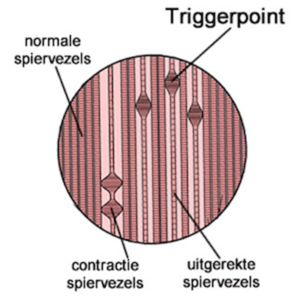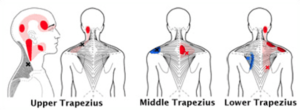Trigger point complaints
Our therapists will guide and treat you to help you recover as best as possible from your trigger point complaints.
Trigger point complaints
In this article ‘What is a trigger point’ we explain what the most common cause of chronic pain is.
Trigger points can cause many unexplained complaints and that is why it is important to do proper research into this.
Don’t keep walking around with your complaint and make an appointment!

The question: ‘What is a trigger point?’ is often asked in practice. Myofacial trigger points (MTrP) are also called muscle knots. A muscle knot is a small, local cramp in the muscle. This cramp causes waste products to accumulate in this place. This causes a local thickening with poor blood flow, causing waste products to accumulate. This is how trigger points with referred pain arise. Referred pain is common with trigger points and this cramp in the muscle has consequences in other parts of the body. You can have multiple muscle knots in the same muscle, but you can also have multiple muscle knots in different muscles at the same time. From the outside, these muscle knots can be felt as painful hard bumps or strings. This can be caused by prolonged static tension, incorrect posture or a short-term heavy effort.
According to trigger point researchers Drs. Janet Travell and David Simons, an MTrP is a very irritable, localized spot in the muscle in the form of a lump. It is striking that a study by Travell and Simons showed that 75% of pain complaints are caused by myofascial trigger points. Treating this MTrP can therefore be an important part of the recovery from pain complaints. Read more about trigger point therapy here.
What is a triggerpoint?
A myofascial trigger point is a palpable lump in the muscle. It is painful when you press on this lump. When you put a lot of pressure on it, this can cause radiating pain in another part of the body. The pain can also radiate to other areas in fixed patterns. This is called ‘referred pain’. The myofascial pain often radiates to a place at some distance from the TrP in a pattern that is recognizable to the therapist. A trigger point or muscle knot can cause restricted movement, stiffness, loss of strength and pain complaints. A muscle is made up of separate muscle fibers. In a normal resting position, a muscle fiber is neither stretched nor contracted. When there is a trigger point in the muscle, it appears that the muscle fibers are more contracted at certain points in a resting state than in the surrounding area.
Trigger points and energy
When talking about these muscle knots, we often also speak of a cramped muscle. Why does a muscle actually go into cramp? and how do trigger points arise?
A muscle can only survive in an oxygen-rich environment (basic). When trigger points develop in the muscle, blood flow is impeded, resulting in the environment becoming increasingly oxygen-poor (alkaline).
A muscle can contract and relax. Energy is needed for both movements. ATP is needed for contraction and ADP for relaxation. So when we cannot supply sufficient energy to the muscle, the muscle not only has difficulty contracting, but also relaxing. This results in a local cramp within the muscle. This causes poor blood flow. When you are at rest, a muscle fiber is neither stretched nor contracted.
A hardened muscle
Above we just talked about trigger points, but can they now also be clearly felt? Yes, they can certainly be felt. We can feel them from the outside by palpating across the muscle. When muscle knots are present, we feel hardened strands or bumps. When we slowly apply pressure to these, they are painful and can cause pain in another part of the body. We call this ‘referred pain’.
A myofascial trigger point can manifest itself in two ways: Active or Latent. An Active MTrP causes pain or another unpleasant sensation. A Latent MTrP causes stiffness and is usually caused by an inactive lifestyle with a lot of sitting, little exercise and certain eating habits.
Referred pain
Referred pain is radiating pain. Referred pain is the most characteristic of a trigger point. The pain is then perceived at a different location than where the tissue damage is located. There are various theories about how this referred pain can arise. The most plausible theory about the origin of referred pain is that the sensory signals from the area of tissue damage end up on the same part of the spinal cord as the signals from the area where the pain is felt. These signals are then misinterpreted by the brain, causing it to think that the signals come from the other, undamaged area. Each trigger point has a fixed area to which the pain radiates. A well-known example is that a headache can be the result of a Tp in the trapezius muscle.
Types of trigger points
Not every trigger point is the same. This depends on the size, shape and type of muscle in which the Tp is located. Below you can read an overview of the different types of Tp.
Primaire triggerpoints: These MTrP arise in the middle of the muscle belly and these MTrP arise as a result of overload. These primary trigger points are the cause of the complaints.
Secondary triggerpoints: These MTrP arise as a result of the primary MTrP and are often seen in the muscle that helps the muscle with the primary MTrP (synergist) or in the muscle that has the opposite function of the muscle with the primary MTrP (antagonist). Secondary MTrP are often less persistent than the primary Tp, but they do ensure that the complaints are maintained.
Attachment trigger point: This is a trigger point that is located in the attachment of a muscle to a bone.
Diffuse trigger points: these are MTrP spread over a larger region. This can be seen, for example, in scoliosis. In this case, there are multiple MTrP behind each other.
Active trigger points: Active MTrP are pressure sensitive and also cause referred pain.
Inactive trigger points: Inactive MTrP are not pressure sensitive and do not cause pain, but do cause stiffening of the muscle. Inactive MTrP usually arise as a result of primary, active MTrP and they can become active through activation of the primary MTrP or through an acute accident or injury.

Wat zijn symptomen van triggerpoints?
The complaints that trigger points cause are extremely diverse. Trigger points have various symptoms that can be used to recognize the presence of MTrP. An MTrP (also called a muscle knot) is a palpable lump in the muscle. Sometimes multiple lumps can be felt next to each other. The MTrP is often located in a palpably tight strand of muscle tissue. This can feel like a tendon. The skin above an MTrP is often warmer or colder than the skin elsewhere. The skin above the MTrP can also be moister. The skin above the trigger point is often less elastic than the skin elsewhere. Read more about trigger point therapy here.
It is painful when you press on this lump. The intensity of the pain depends on several factors, such as the location of the trigger point, whether the MTrP is active or not and whether it is a primary or secondary trigger point. An important symptom of MTrP is pain according to fixed patterns (referred pain). The pain is then perceived at a different location than where the tissue damage is located. Each MTrP has its own area where referred pain can occur. Some examples of trigger points and the areas where pain can occur:
- A MTrP in the middle gluteal muscle can cause radiating pain in the hip or lower back.
- A MTrP in the quadriceps muscle can cause radiating pain in the lower back.
- A MTrP in the calf muscle can cause radiating pain in the tendon plate under the foot.
- A MTrP in the biceps muscle of the upper arm can cause radiating pain in the elbow region.
- A MTrP in the trapezius muscle can cause radiating pain to the head (headache).
Another symptom of trigger points is that the entire muscle in which the MTrP is located is tense and feels stiff. One develops a restriction of movement. It is possible that one can use the muscle less well due to a decrease in strength. As a result of the increased muscle tension, tendon irritations can also occur, because there is more pulling force on the attachment of these muscles to the bone. The increased muscle tension can also cause pinching of nerves or blood vessels. As a result of nerve pinching, one can get tingling, a numb feeling or, for example, itching.
In summary, symptoms of trigger points are:
- local, deep pain when pressure is applied to the MTrP
- continuous pain without pressure on the MTrP
- referred pain according to fixed patterns
- the deep pain can feel sharper when moving a palpable lump sometimes in combination with a hardened cord the skin above a trigger point can feel warmer or colder and can be
- moist
- increased muscle tension
- stiffness
- restriction of movement and possible loss of strength
- tendon irritations
- pinching of nerves or blood vessels
In addition, having trigger points can lead to reflex reactions of the body due to a disruption of the autonomic nervous system. Examples of these reactions are increased saliva production, red eyes, a drooping eyelid, blurred vision or goose bumps, for example.
The types of trigger point treatments?
Trigger points can be treated in different ways. The physiotherapist can use (a combination of) the following forms of therapy.
- Manual pressure techniques
- Dry needling therapy
- Trigger point therapy
- Stretching techniques
- Advice and coaching
Reduction:
- take sufficient breaks during strenuous activities
- slowly stretch the muscle in question
- temperature at which the body can relax, pleasant warmth
- physiotherapy (dry needling, trigger point therapy)
- breathing exercises / meditation
What makes a trigger point more painful and what reduces the pain?
Worsening:
- too much and one-sided use of a muscle with too few breaks.
- an acute shortening of a muscle
- cooling (scant clothing),
- stress, (suppressed) emotions and traumas
- too much pressure on the muscle in question
- unhealthy eating
- bad breathing
If you would like to make an appointment to be examined by a physiotherapist based on the above, click Here
WANT TO KNOW MORE?
About your 1st appointment or do you have another question? Call, WhatsApp or email us, we are happy to help you with your recovery!
“Your health is our passion”
